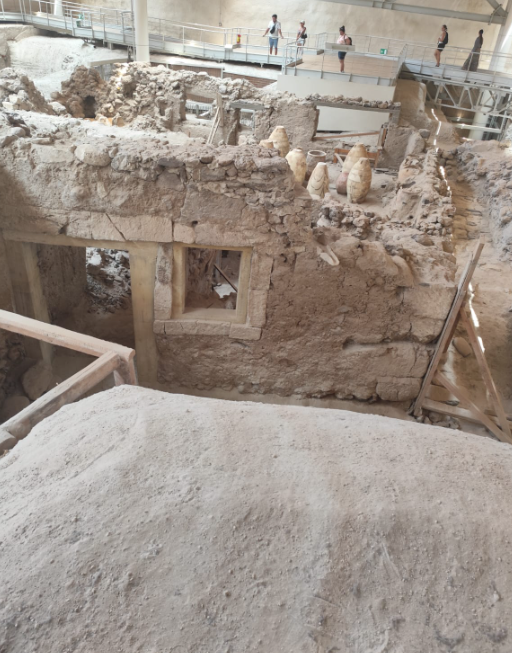The Minister of Culture Lina Mendoni carried out an autopsy on the two emblematic archaeological sites of Santorini – ancient Thira and the prehistoric settlement of Akrotiri – as part of its presence on the island for the inauguration of the new Archaeological Museum of Thira.
The minister toured the area Hunting and was informed of the course of the work being carried out by EFA Cycladic as well as through the program contract between the Ministry of Culture and the Municipality of Thira. He gave instructions on the update of the existing strategic plan for the ancient city, and requested that the existing building be used immediately at the entrance of the site – made under the 3rd CSF – as a refreshment room. He also requested that existing sophistication with new stone constructions, more compatible with the character of the archaeological landscape, be replaced immediately.
Particular emphasis was placed on boosting the information of visitors through additional explanatory signs, interpretation and reading stops. Despite the completion of cleaning and deforestation, the minister called for a study of controlled trees management, in particular the pine trees, for the prevention of fire risk.
Ancient Thira, built on the hill in Mount Mountain, was the urban, administrative and religious center of the city-state of Thira from the 8th century. B.C. up to the Early Christian times. He has experienced a period of prosperity during Ptolemaic domination (288–145 BC), and has been the subject of systematic archaeological research from the 19th century until today. The venue was highlighted by European co -financing between 2003-2008 and is today the fourth archaeological site of the Cyclades, with 50,000 visitors a year.
Subsequently, the Minister of Culture visited the archaeological site of Akrotiri, where he was briefed by the Department of the Department of Restoration of Ancient Monuments of the Ministry of Culture, Michalis Lefantzis, about the design and progress of the restoration studies of the Monument. A specialized renovation study at the implementation level has already been assigned for the first time in sector D, while a research program is being drawn up for studying the whole monument in order to solve the problems of structural adequacy. The study for sector D is completed late September. All works and studies are prepared with resources of the Ministry of Culture.
PARALLY, the Minister called for the preparation of a museological and museographic study of the report of the archaeological site of the Akrotiri, as well as to draw up a proposal by the Ephorate of Antiquities of Cyclades, for the extension of the excavation research in order to reveal a largest part of this only prehistoric center. A directive on the construction of new stops for visitors was granted, while maintenance work of the roof and corridors will be carried out by the Ephorate of Antiquities of Cyclades, with the aim of completing them before the summer of 2026. At the same time, the study of the redevelopment of the environment was completed in the context of the environment.
Akrotiri, inhabited by the 3rd millennium BC, evolved into one of the most important urban and shopping centers in the 17th century BC, before being destroyed by the volcanic eruption. Its excellent preservation is due to the volcanic materials that covered it. The excavations began in 1967 and continue to this day. The site is protected by an innovative bioclimatic roof and is the most visited archaeological site of the Cyclades, with 270,000 visitors a year.
Source :Skai
I am Frederick Tuttle, who works in 247 News Agency as an author and mostly cover entertainment news. I have worked in this industry for 10 years and have gained a lot of experience. I am a very hard worker and always strive to get the best out of my work. I am also very passionate about my work and always try to keep up with the latest news and trends.












